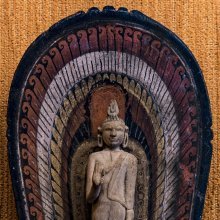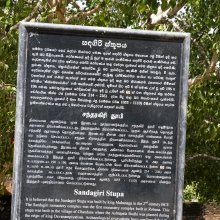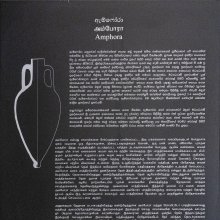Samanvita, Shamanvita: 14 definitions
Introduction:
Samanvita means something in Buddhism, Pali, Hinduism, Sanskrit, Marathi, Hindi. If you want to know the exact meaning, history, etymology or English translation of this term then check out the descriptions on this page. Add your comment or reference to a book if you want to contribute to this summary article.
Alternative spellings of this word include Samanvit.
Images (photo gallery)
In Hinduism
Purana and Itihasa (epic history)
Source: archive.org: Shiva Purana - English TranslationSamanvita (समन्वित) refers to “accompanying”, according to the Śivapurāṇa 2.3.18 (“Description of the perturbation caused by Kāma”).—Accordingly, as Brahmā narrated: “On seeing the untimely display of spring, Śiva the lord, who had assumed a physical body indulging in divine sports, thought it surprising. But He, the chief of the self-controlled and the remover of man’s misery continued his severe penance. When spring spread everywhere, Kāma accompanied by Rati [i.e., rati-samanvita] stood on his left side, with the arrow of mango blossom taken out and kept in readiness. [...]”.

The Purana (पुराण, purāṇas) refers to Sanskrit literature preserving ancient India’s vast cultural history, including historical legends, religious ceremonies, various arts and sciences. The eighteen mahapuranas total over 400,000 shlokas (metrical couplets) and date to at least several centuries BCE.
Shaivism (Shaiva philosophy)
Source: SOAS University of London: Protective Rites in the Netra TantraSamanvita (समन्वित) refers to “(being) endowed with (Śakti)”, according to the Netratantra of Kṣemarāja: a Śaiva text from the 9th century in which Śiva (Bhairava) teaches Pārvatī topics such as metaphysics, cosmology, and soteriology.—Accordingly, [verse 22.5-10ab]—“Listen! I will speak to the question that remains in your heart. All the innumerable Mantras, on all occasions, have the majesty of Śiva and Śakti, all are endowed with Śakti (sarva-śakti-samanvita), all grant rewards and liberation, and [all] are nourished by one's own Śakti. However, the highest Deva is tranquil, in possession of imperceptible guṇas, [namely] Śiva who consists of all, who is pure, and who is to be understood as unsurpassed. [...]

Shaiva (शैव, śaiva) or Shaivism (śaivism) represents a tradition of Hinduism worshiping Shiva as the supreme being. Closely related to Shaktism, Shaiva literature includes a range of scriptures, including Tantras, while the root of this tradition may be traced back to the ancient Vedas.
Yoga (school of philosophy)
Source: ORA: Amanaska (king of all yogas): A Critical Edition and Annotated Translation by Jason BirchSamanvita (समन्वित) refers to the “connected feelings” (with one’s caste-class and religious disciplines), according to the Sarvajñānottara verse 20.34-39.—Accordingly, while discussing the culmination of detachment (for the process of attaining the no-mind state): “Having abandoned those feelings connected with his region, caste, his caste-class and religious disciplines (varṇāśrama-samanvita), the wise should meditate on his own [inner] state. Abandoning all such feelings as ‘this is [my] mantra’, ‘this is [my] deity’, ‘this is [my] meditation’ [or] ‘this is [my] austerity’, he should meditate on his own [inner] state. [...]”.

Yoga is originally considered a branch of Hindu philosophy (astika), but both ancient and modern Yoga combine the physical, mental and spiritual. Yoga teaches various physical techniques also known as āsanas (postures), used for various purposes (eg., meditation, contemplation, relaxation).
Shaktism (Shakta philosophy)
Source: Google Books: ManthanabhairavatantramSamanvita (समन्वित) refers to an “association” (i.e., “this together with that”), according to the Ṭīkā (commentary) on the Manthānabhairavatantra, a vast sprawling work that belongs to a corpus of Tantric texts concerned with the worship of the goddess Kubjikā.—Accordingly, “[...] The venerable one called Ciñciṇīśa is that Śambhu by nature and is born from his own body as a subtle exertion. And what else is there? He should be worshipped along with (samanvita) the Kukārā Vidyā. This is the connection (between the words) with what was said before. [...]”..

Shakta (शाक्त, śākta) or Shaktism (śāktism) represents a tradition of Hinduism where the Goddess (Devi) is revered and worshipped. Shakta literature includes a range of scriptures, including various Agamas and Tantras, although its roots may be traced back to the Vedas.
In Buddhism
Tibetan Buddhism (Vajrayana or tantric Buddhism)
Source: OSU Press: Cakrasamvara SamadhiSamanvita (समन्वित) refers to “being full of (food to be enjoyed)”, according to the Guru Mandala Worship (maṇḍalārcana) ritual often performed in combination with the Cakrasaṃvara Samādhi, which refers to the primary pūjā and sādhanā practice of Newah Mahāyāna-Vajrayāna Buddhists in Nepal.—Accordingly, “Oṃ an offering of eatables all combined, full of food to be enjoyed (khādyabhojya-samanvita), Provided with drink to be enjoyed, an acceptable offering from her, Five kinds of virtuous conduct, completely full of egg-born fish, Of one mind with the Nirvikalpa, eat and enjoy Hūṃ”.

Tibetan Buddhism includes schools such as Nyingma, Kadampa, Kagyu and Gelug. Their primary canon of literature is divided in two broad categories: The Kangyur, which consists of Buddha’s words, and the Tengyur, which includes commentaries from various sources. Esotericism and tantra techniques (vajrayāna) are collected indepently.
Languages of India and abroad
Marathi-English dictionary
Source: DDSA: The Molesworth Marathi and English Dictionarysamanvita (समन्वित).—a S Consecutive or successive naturally: also harmoniously or suitably connected, conjoined, mingled, blended. 2 Possessed of, endowed with, being connected with.
Marathi is an Indo-European language having over 70 million native speakers people in (predominantly) Maharashtra India. Marathi, like many other Indo-Aryan languages, evolved from early forms of Prakrit, which itself is a subset of Sanskrit, one of the most ancient languages of the world.
Sanskrit dictionary
Source: DDSA: The practical Sanskrit-English dictionarySamanvita (समन्वित).—p. p.
1) Connected with, connected in natural order.
2) Followed.
3) Endowed with, possessing, full of.
4) Affected by.
Source: Cologne Digital Sanskrit Dictionaries: Shabda-Sagara Sanskrit-English DictionarySamanvita (समन्वित).—mfn.
(-taḥ-tā-taṃ) Possessed of, endowed with, possessing, affected by, full of. E. sam intensitive or conjunctive, anvita endowed with.
Source: Cologne Digital Sanskrit Dictionaries: Cappeller Sanskrit-English DictionarySamanvita (समन्वित).—[adjective] accompanied by, joined or connected with, full or possessed of ([instrumental] or —°).
Source: Cologne Digital Sanskrit Dictionaries: Monier-Williams Sanskrit-English Dictionary1) Śamānvita (शमान्वित):—[from śama > śam] mfn. devoted to quietism, [Muṇḍaka-upaniṣad]
2) Samanvita (समन्वित):—[=sam-anvita] [from samanv-i] mfn. connected or associated with, completely possessed of, fully endowed with, possessing, full of ([instrumental case] or [compound]), [Śvetāśvatara-upaniṣad; Manu-smṛti; Mahābhārata] etc.
3) [v.s. ...] corresponding or answering to ([compound]), [Rāmāyaṇa]
Source: Cologne Digital Sanskrit Dictionaries: Yates Sanskrit-English DictionarySamanvita (समन्वित):—[sama-nvita] (taḥ-tā-taṃ) a. Possessed of.
Source: DDSA: Paia-sadda-mahannavo; a comprehensive Prakrit Hindi dictionary (S)Samanvita (समन्वित) in the Sanskrit language is related to the Prakrit word: Samannia.
Sanskrit, also spelled संस्कृतम् (saṃskṛtam), is an ancient language of India commonly seen as the grandmother of the Indo-European language family (even English!). Closely allied with Prakrit and Pali, Sanskrit is more exhaustive in both grammar and terms and has the most extensive collection of literature in the world, greatly surpassing its sister-languages Greek and Latin.
Hindi dictionary
Source: DDSA: A practical Hindi-English dictionarySamanvita (समन्वित) [Also spelled samanvit]:—(a) coordinated; harmonized; hence ~[ti] (nf).
...
Kannada-English dictionary
Source: Alar: Kannada-English corpusSamanvita (ಸಮನ್ವಿತ):—[adjective] mixed; blended; united.
--- OR ---
Samanvita (ಸಮನ್ವಿತ):—[noun] that which mixed, blended or united.
--- OR ---
Samanvīta (ಸಮನ್ವೀತ):—[adjective] = ಸಮನ್ವಿತ [samanvita]1.
Kannada is a Dravidian language (as opposed to the Indo-European language family) mainly spoken in the southwestern region of India.
See also (Relevant definitions)
Partial matches: Anvita, Sam, Cama, Sama.
Ends with (+16): Abhayasamanvita, Atikopasamanvita, Bahuhastasamanvita, Balasamanvita, Bhavasamanvita, Brahmavishnusamanvita, Duhkhashokasamanvita, Ganasamanvita, Harshasamanvita, Kalasamanvita, Kopasamanvita, Krodhasamanvita, Kshamanvita, Kulashilasamanvita, Kutuhalasamanvita, Mahabalasamanvita, Pashcattapasamanvita, Raja-grahya-samasta-pratyaya-samanvita, Ratisamanvita, Ratnasamanvita.
Full-text (+44): Harshasamanvita, Kalasamanvita, Kopasamanvita, Shraddhasamanvita, Kulashilasamanvita, S-atavi-vitapa-samanvita, Virasamanvita, Krodhasamanvita, Vatapittaja, Samhalalamaka-samanvita, Samannia, Sarvaratnasamanvita, Shubhasamanvita, Duhkhashokasamanvita, Raja-grahya-samasta-pratyaya-samanvita, Vastu-kshetra-jaladhara-garta-marga-samanvita, Shlakshnarupasamanvita, Yashomedhasamanvita, Shokaduhkhasamanvita, Pashcattapasamanvita.
Relevant text
Search found 25 books and stories containing Samanvita, Sam-anvita, Sama-nvita, Śamānvita, Samanvīta, Shamanvita; (plurals include: Samanvitas, anvitas, nvitas, Śamānvitas, Samanvītas, Shamanvitas). You can also click to the full overview containing English textual excerpts. Below are direct links for the most relevant articles:
Garga Samhita (English) (by Danavir Goswami)
Verse 3.9.11 < [Chapter 9 - The Birth of Śrī Girirāja]
Verse 3.1.28 < [Chapter 1 - The Worship of Śrī Girirāja]
Verses 2.24.4-5 < [Chapter 24 - The Story of Asuri Muni in the Rāsa-dance Pastime]
Chaitanya Bhagavata (by Bhumipati Dāsa)
Verse 1.8.58 < [Chapter 8 - The Disappearance of Jagannātha Miśra]
Verse 3.9.225 < [Chapter 9 - The Glories of Advaita]
Verse 1.16.123 < [Chapter 16 - The Glories of Śrī Haridāsa Ṭhākura]
Shrimad Bhagavad-gita (by Narayana Gosvami)
Verse 18.26 < [Chapter 18 - Mokṣa-yoga (the Yoga of Liberation)]
Verse 13.2 < [Chapter 13 - Prakṛti-puruṣa-vibhāga-yoga]
Verse 9.1 < [Chapter 9 - Rāja-guhya-yoga (Yoga through the most Confidential Knowledge)]
Vakyapadiya of Bhartrihari (by K. A. Subramania Iyer)
Verse 2.216-217 < [Book 2 - Vākya-kāṇḍa]
Amarakoshodghatana of Kshirasvamin (study) (by A. Yamuna Devi)
Tāla (beat) or Measure of time < [Chapter 4 - Cultural Aspects]


